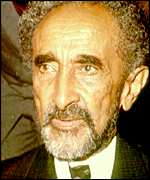The reburial of Haile Selassie
November 4, 2000
Ethiopia's last Emperor, Haile Selassie I,
is being buried in Addis Ababa on Sunday,
almost 25 years after he died.
Trinicenter Special
Abstracts: BBC News & Ethiopians.com
1892: Born near Harar
1928: Ascends to throne of Shoa
1930: Ascends to imperial throne
1936: Exiled after Italian invasion
1941: Returns to Addis Ababa
1974: Deposed by Mengistu
1975: Dies while in custody
As a result of efforts spearheaded by The Emperor Haile Selassie Foundation, the remains of the last Ethiopian king will be buried on November 5, 2000 in Addis Ababa, Ethiopia at the Holy Trinity Church. The burial date coincides with the late Emperor's coronation date of 1928.
The event is planned to be a public service where residents of Addis Ababa and the environ and invited guests of the foundation will attend. A huge turnout is expected as Ethiopians seem to think it is fit to give their last emperor his official burial.
While opinions about Haile Selassie among Ethiopians vary a lot, a consensus seems to be emerging that establishes him as a benevolent king who ruled over a largely peaceful and relatively prosperous reign. The Emperor is credited in establishing numerous schools, hospitals, banks, airlines and infrastructure for a modern government. Haile Selassie's contribution in making his country known across the globe and projecting an image of civilization, power and dignity will be judged by History, as perhaps his biggest achievement. The Emperor's critics blame him for failing to arrange for a transition of power as he was getting old.
Just days before the reburial, the present Ethiopian Government attacked the Emperor's legacy, accusing him of oppression and brutality.
In a statement issued on Tuesday, the ruling Ethiopian People's Revolutionary Democratic Front (EPRDF), broke its silence, after almost a decade, denouncing the Emperor as a despot and tyrant who oppressed and exploited the masses.
It is believed that the statement is aimed at defusing rising criticism at the government's lack of support for the reburial of the man who is regarded as a figurehead of African independence.
In the months leading to this reburial, members of the Ethiopian imperial family in exile and supporters of Emperor Haile Selasssie, have called on the Ethiopian Government to make the funeral a state occasion.
But the EPRDF has refused, saying that it is "a family affair, rather than a state occasion".
Despite this, with the help of contributions from Ethiopians in the country and those living in the diaspora, the funeral is going ahead. Organisers say it will be a "modest, yet dignified affair".
Requiem masses and vigils have been held in all 500,000 churches and monasteries in Ethiopia, according to Archbishop Girima, of the Ethiopian Orthodox Church.
The funeral cortege will leave Ba'ata Mariam Geda Church at dawn and follow a 10km (six mile) route to the Trinity Cathedral, via the main Meskal Square in Addis Ababa.
The Patriarch of the Ethiopian Orthodox Church, Abune Paulos, is expected to deliver a sermon in the presence of government leaders, religious figures, foreign diplomats and representatives of international organisations, like the Organisation of African Unity and the United Nations.
Haile Selassie ruled Ethiopia for 45 years before he was overthrown by the Marxist dictator Mengistu Haile Mariam in 1974.
The 81-year-old emperor was detained in his palace by Mengistu's soldiers.
He died a year later, many believe murdered by his captors. His remains were found in 1992, buried under a toilet in the Imperial Palace.
More than 25 years have passed since his death, but his legacy still lives on. Haile Selassie is one of the founding fathers of the OAU and is viewed by many as the figurehead of African independence, for his defiance against the Italian colonial invasion in the 1930s.
He is also revered by the million-strong Rastafarian community, who believe that the Ethiopian emperor either remains alive and well, or ascended bodily into heaven.
When Haile Selassie was enthroned in 1930, he became not only emperor of Ethiopia, but also god to the fledgling Rastafarian movement in Jamaica.
While most Rastafarians have condemned the funeral, a few hundred have arrived in Addis Ababa for the burial, insisting they are here to "merely observe, rather than to participate."
Ras Lumumba, a Sudanese Rastafarian who came to settle in Ethiopia three years ago, says the Emperor is their Messiah or Jah.
"Haile Selassie is King of Kings, Lord of Lords, and the conquering lion of the Tribe of Judah. He is everything to us Rastafarians and we will never accept that he is dead."
Ethiopian Government Spokesperson
Crown Council of Ethiopia
Rastafarian links
Selassie Family Web
Imperial Ethiopia
Cyber Ethiopia
